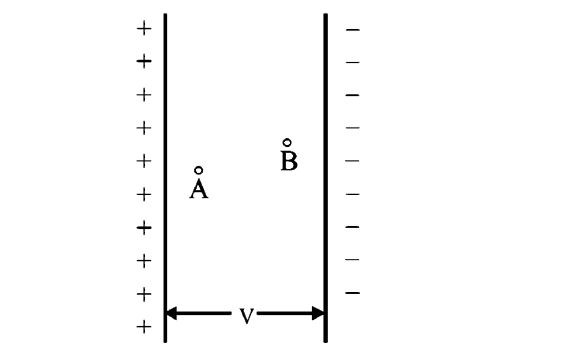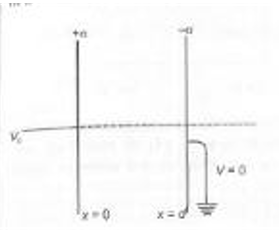The distnace between the plates of a parallel plate capacitor is 3 mm the potential difference applied is 3×105 V. If an electron travels from one plate to another the change in its potential energy is
3×105 eV
900 eV
108 eV
Negligible
To find the change in potential energy of an electron traveling from one plate of a parallel plate capacitor to another, we can use the formula:
ΔU=Q⋅ΔV
Where:
- ΔU is the change in potential energy,
- Q is the charge of the electron,
- ΔV is the potential difference between the plates.
Step 1: Identify the charge of the electron
The charge of an electron Q is given as:
Q=1.6×10−19 C
Step 2: Identify the potential difference
The potential difference ΔV is given as:
ΔV=3×105 V
Step 3: Calculate the change in potential energy
Now, substituting the values into the formula:
ΔU=Q⋅ΔV=(1.6×10−19 C)⋅(3×105 V)
Calculating this gives:
ΔU=4.8×10−14 J
Step 4: Convert the change in potential energy to electron volts
To convert joules to electron volts, we use the conversion factor where 1 eV=1.6×10−19 J:
ΔU (in eV)=ΔU (in J)1.6×10−19 J/eV
Substituting the value:
ΔU (in eV)=4.8×10−14 J1.6×10−19 J/eV=3×105 eV
Final Answer
Thus, the change in potential energy of the electron as it travels from one plate to another is:
ΔU=3×105 eV
- ΔU is the change in potential energy,
- Q is the charge of the electron,
- ΔV is the potential difference between the plates.
The charge of an electron Q is given as:
Q=1.6×10−19 C
The potential difference ΔV is given as:
ΔV=3×105 V
Now, substituting the values into the formula:
ΔU=Q⋅ΔV=(1.6×10−19 C)⋅(3×105 V)
ΔU=4.8×10−14 J
To convert joules to electron volts, we use the conversion factor where 1 eV=1.6×10−19 J:
ΔU (in eV)=ΔU (in J)1.6×10−19 J/eV
ΔU (in eV)=4.8×10−14 J1.6×10−19 J/eV=3×105 eV
Thus, the change in potential energy of the electron as it travels from one plate to another is:
ΔU=3×105 eV
Similar Questions
The space between the plates orf a parallel plate capacitor is completely filled with a meterail of resistaivity 2×1011Ωm and dielectric constant 6. Capacity of the capacitor with the given dielectric medium between the paltes is 20uF. Find the leakage current if a potential difference 2500 V is applied across the capacitor.
View SolutionThe space between the plates of a parallel plate capacitor is completely filled with a material of resistivity 2×1011Ωm and dielectric constant 6. Capacity of the capacitor with the given dielectric medium between the plates is 20μF. Find the leakage current if a potential difference 2500V is applied across the capacitor.
View SolutionThe' distance between the plates of a parallel plate capacitor is d. A metal plate of thickness d/2 is placed between the plates. What will e its effect on the capacitance.
View SolutionTwo protons A and B are placed in between the two plates of a parallel plate capacitor charged to a potential difference V as shown in the figure. The forces on the two protons are identical.
 View Solution
View SolutionThe separation between the plates of a parallel-plate capacitor is 2 mm and the area of its plates is 5cm2. If the capacitor is charged such that it has 0.01J energy stored in it, the electrostatic force of attraction between its plates is _______N.
View SolutionThe voltage between the plates of a parallel plate capacitor of capacitance 1.0μFis changing at rate of 1.0V/s. Find displacement current
View SolutionThe force between the plates of a parallel plate capacitor of capacitance C and distance of separation of the plates d with a potential difference V between the plates, is.
View SolutionIn Millikan's oil drop experiment an oil drop of radius r and change Q is held in equilibrium between the plates of a charged parallel plate capacitor when the potential change is V. To keep a drop radius 2r and with a change 2Q is equilibriu between the plates the potential difference V' required is:
View SolutionIf an electron enters a space between the plates of a parallel plate capacitor at an angle θ1 with the plates and leaves at an angle θ2 to the plates, the ratio of its kinetic energy while entering the capacitor to that while leaving will be
View SolutionA parallel plate capacitor charged to potential difference V0 . The variation of potential V from x= 0 to x= d is best described by
 View Solution
View Solution

